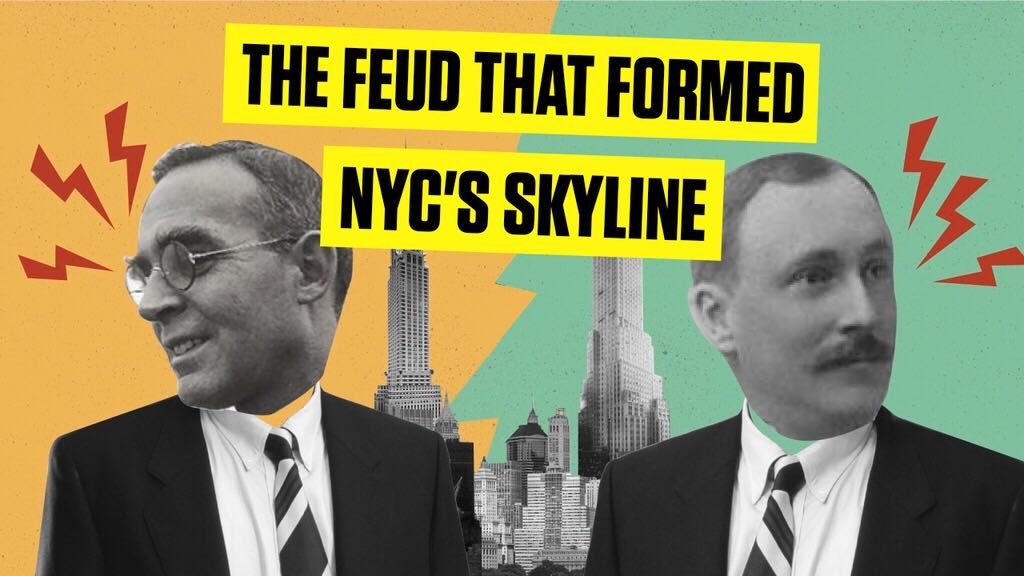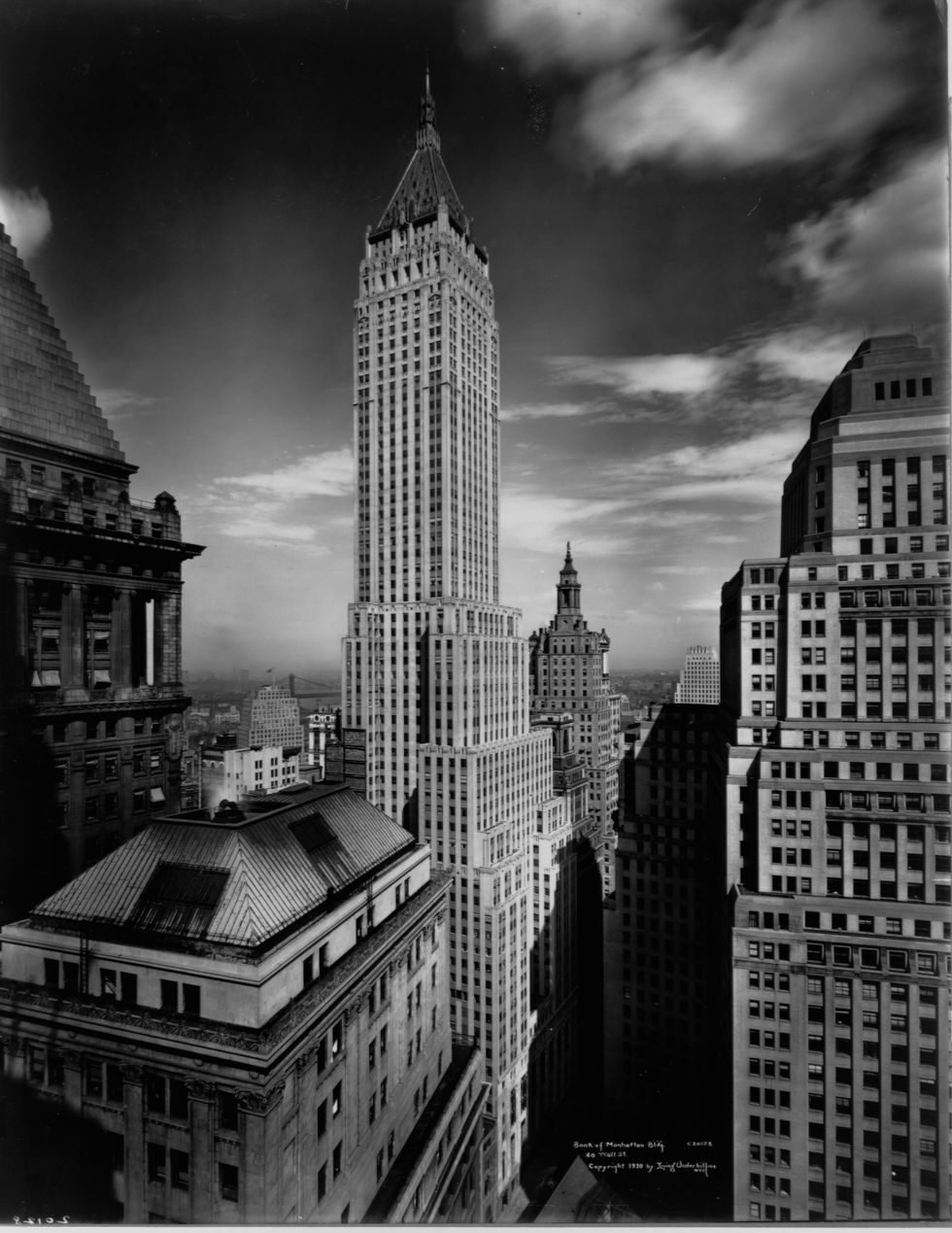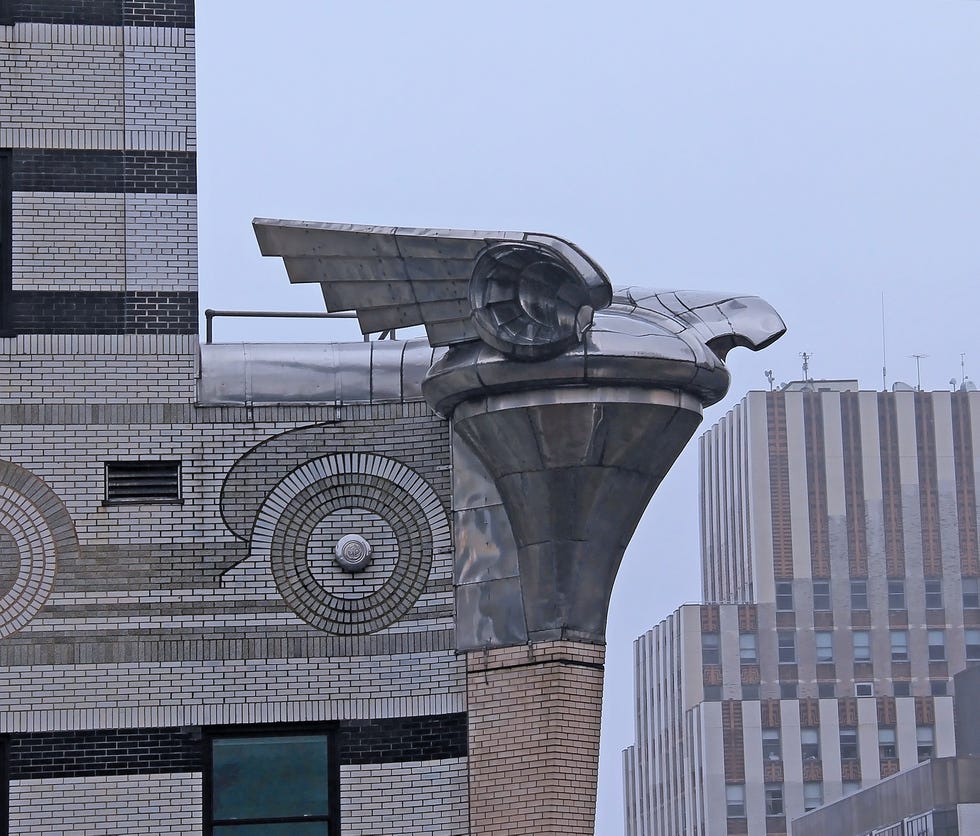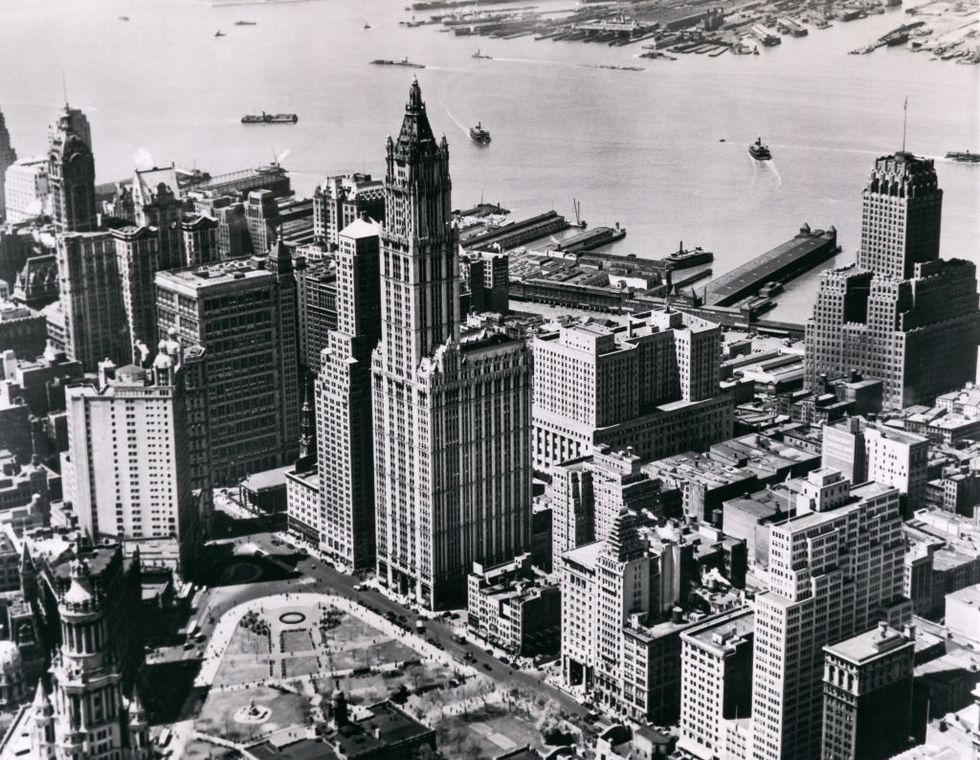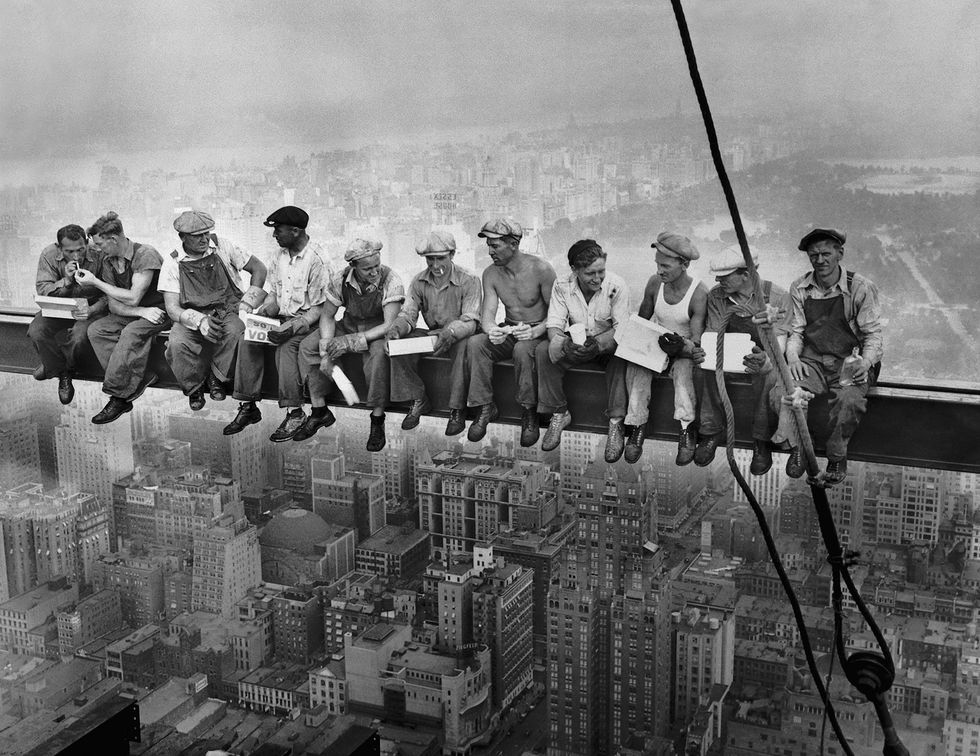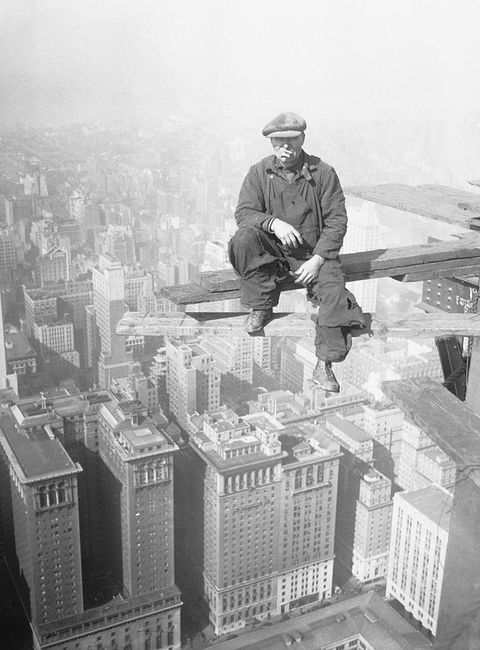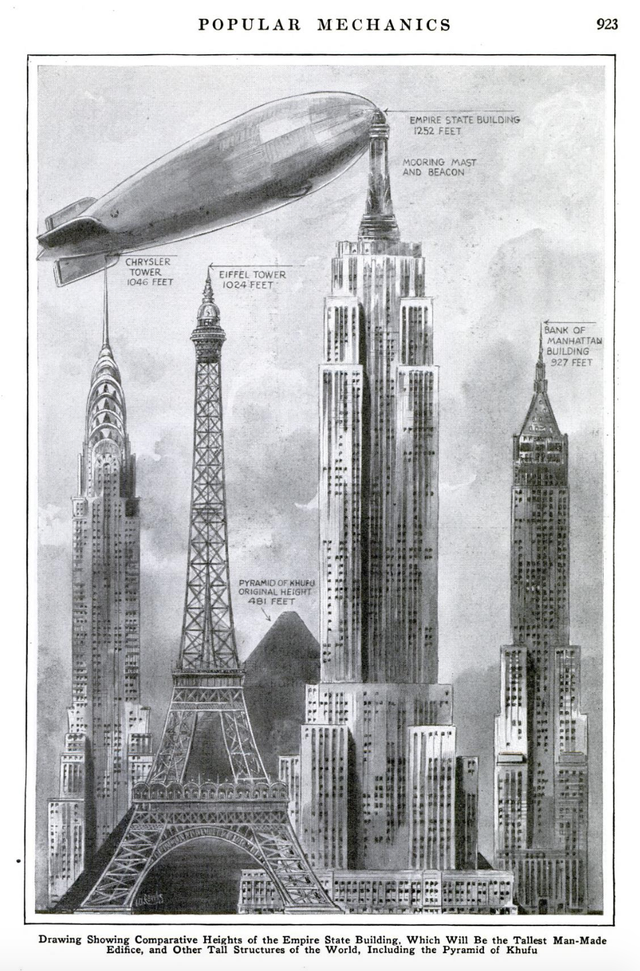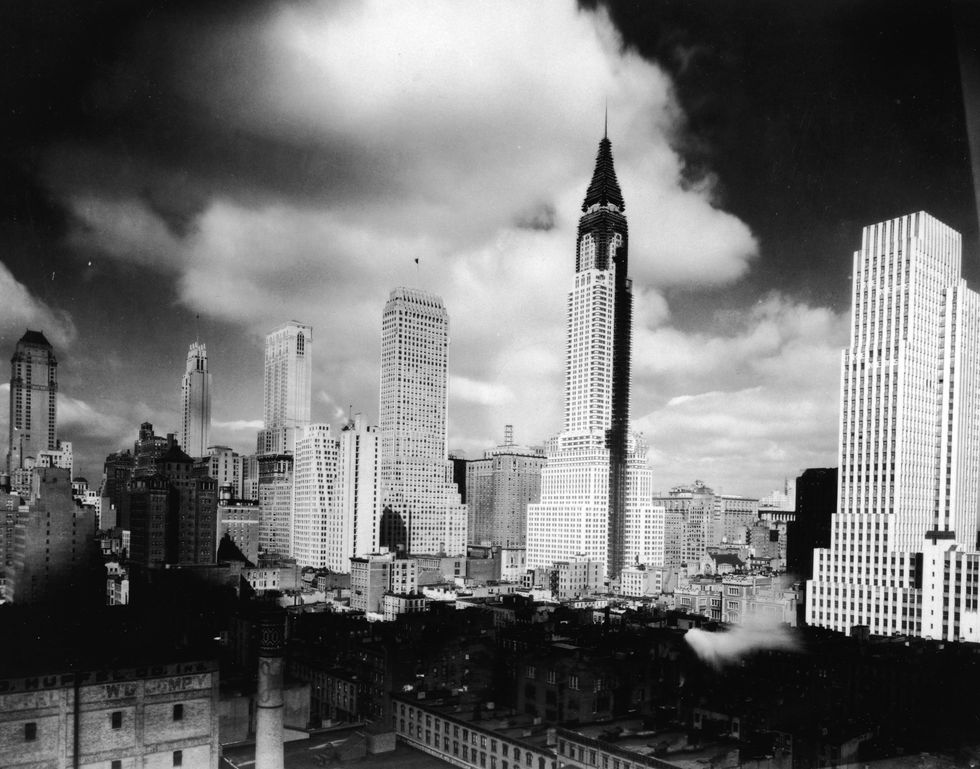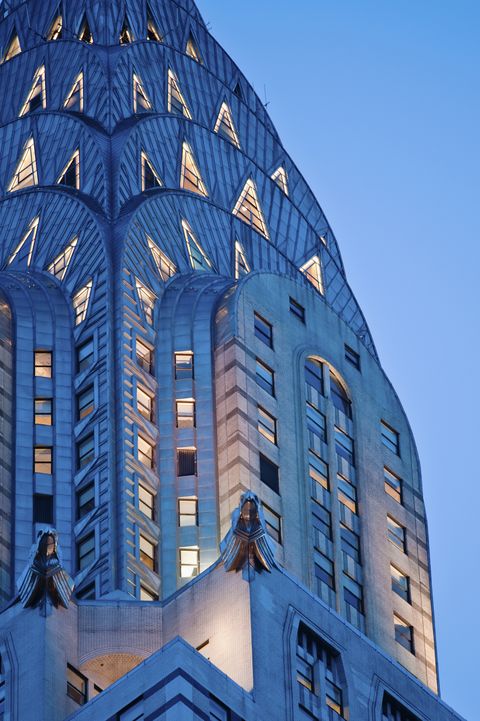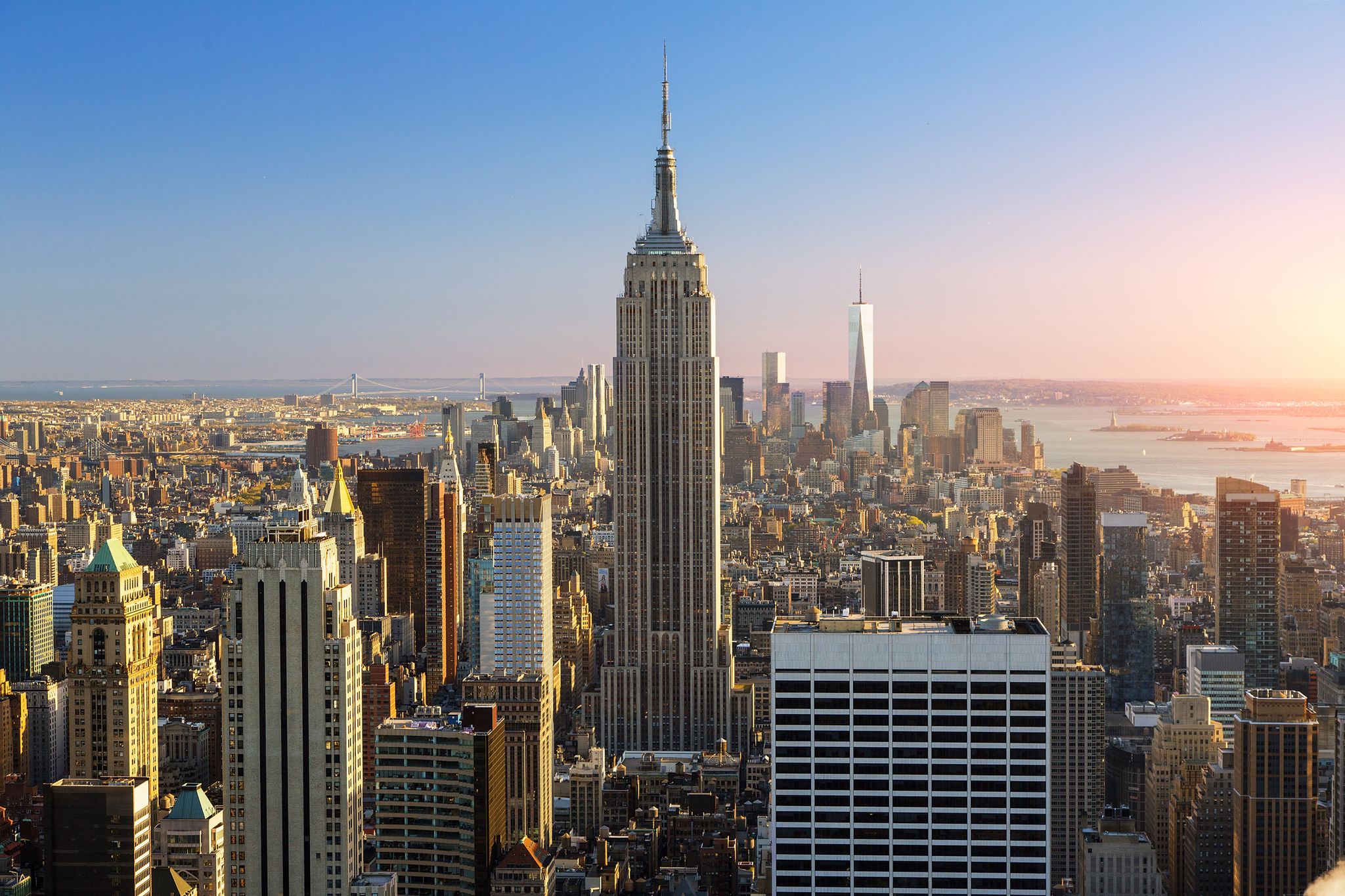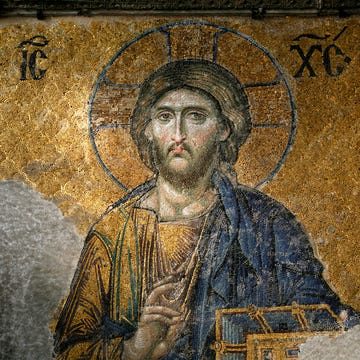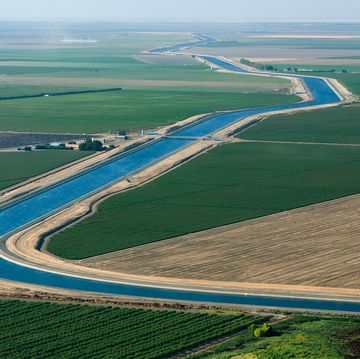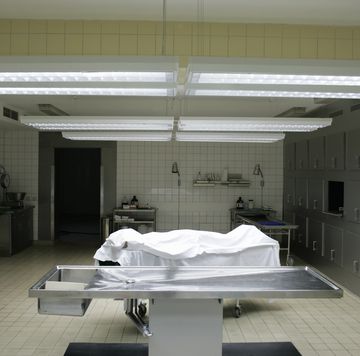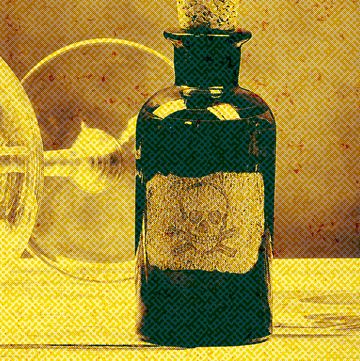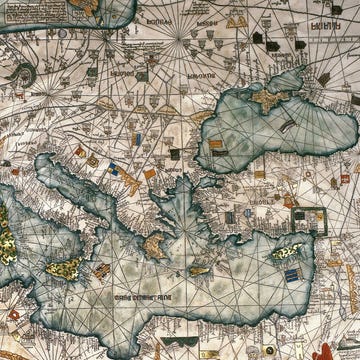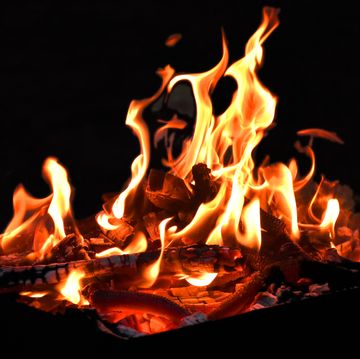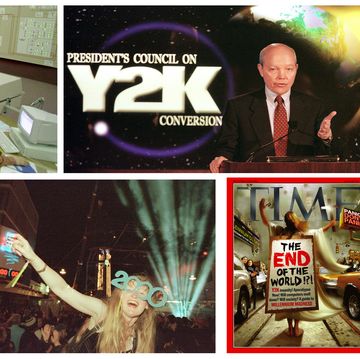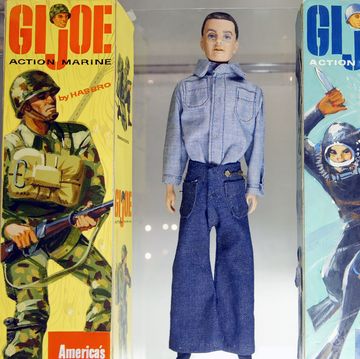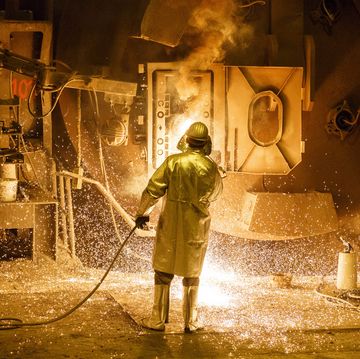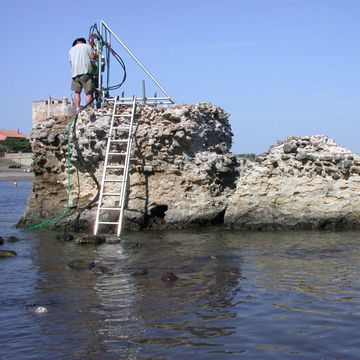Far above the rooftops of Manhattan on October 23, 1929, a crew of construction workers perched themselves around one of the highest human-made peaks in the world. Rumors had swirled that they were planning to hoist a flagpole, but what they were really about to lift was far bigger. From wooden platforms 860 feet in the air, the crew was going to raise and rivet a steel needle weighing 54,000 pounds—the finishing touch of a tower called the Chrysler Building.
A few blocks away, the building’s architect, William Van Alen, looked on. He felt nauseous and dizzy as the spire ascended, last-minute worries seeping into his mind. Maybe the cables would break and drop the 54,000 pounds through the building, or perhaps the crane would fail to lift the needle high enough. If the winds grew too strong, the spire would tip over the edge of the building, fall down more than 70 stories and crash onto the streets below.
Two years of Van Alen’s life had gone into this building. The tower should have topped out months earlier, with a far different design and certainly no spire, but rivalry had intervened. Four miles south, another skyscraper was rising, and its owners had the same goal as the Chrysler developers: To erect the tallest building in the world. And the architect of that tower—a bank at 40 Wall Street—was H. Craig Severance, a man Van Alen once called a friend.
What transpired would transform the built environment of New York City, creating two of its most endearing architectural symbols and catapulting skyscraper design to heights never before seen.
At the Starting Line
A decade before William Van Alen ever dreamed about a skyscraper on 42nd St., all that stood at the current site of the Chrysler Building was a five-story structure with a cigar store at ground level. But World War I had just ended, and New York was growing. Elevators and mass steel production—two necessary components of tall buildings—were becoming mainstream. The tallest building in the world, the Woolworth Building, had topped out at 792 feet above Lower Manhattan. And, as Neal Bascomb wrote in his book Higher: A Historic Race to the Sky and the Making of a City, an architecture firm called “Severance & Van Alen, Architects” was on the rise.
The pair divided its workflow simply. Severance was the salesman, the man who won the jobs. Van Alen was the designer. Together, they created buildings that can still be found around New York, including the Vogar Building on 57th Street and the Bar Building on 44th Street.
But ten years into this partnership, they began having heated arguments.The two best friends disagreed on designs. They lost a job after taking too long. Van Alen was getting all the credit. Resentment grew. In 1924, Van Alen walked out, ending the practice and the friendship forever.
As Van Alen searched for work on his own, a former New York State senator named William Reynolds asked the architect to design a tower to replace a structure he was leasing—the five-story building on 42nd St. Eager for the opportunity, Van Alen spent more than a year sketching, building models, and refining the specs on his vision: the world’s first 800-foot tower. It would be 67 stories, capped by an illuminated glass dome.
Reynolds showed off the renderings to New York’s real estate community and projected its annual rent income at more than $1 million, but he delayed demolition for months. At last, Van Alen learned the truth: Reynolds had no intention of building this tower. The senator wished only to drive up the value of the lease and sell it for a profit. In 1928, he found a buyer in Walter Chrysler, the founder of the Chrysler Corporation.
Chrysler summoned Van Alen to his office two blocks from the site. He didn’t care for the Reynolds design, but wanted to see what else this architect could offer. Chrysler wanted to make a statement, and intended to do so with a tower that would rise higher than any other. Van Alen seemed to have the imagination he sought.
The five-story building was demolished. Excavation followed. Van Alen sent floor plans, sketches, and sections to Chrysler’s office, where the car magnate would spread the papers across the floor and crawl around examining each detail.
They settled on a 67-story, 809-foot skyscraper that could fit 11,000 people. In the facade, Van Alen drew patterns depicting cars moving across the walls. Massive gargoyles, shaped like the radiator caps of a Chrysler vehicle, would spread their wings at each corner of the building. At the top, six overlapping steel arches would rise above each side of the tower to form a crowning parabolic dome. A friend of Van Alen’s later insisted that the idea for the arches was inspired by a bottle of Bacardi.
The design was released to the public in March 1929. That’s when it caught the attention of H. Craig Severance.
On Your Mark
While Van Alen was at work uptown, Severance had been commissioned to design a tower on Wall Street for the Manhattan Company, a bank founded in 1799 by politician Aaron Burr. The building had several investors, and one of them had been trying to persuade the company it should be the one to construct the world’s tallest building. The height to beat was now 809 feet. Severance was all in.
Building tall was expensive. To cut labor costs, the Manhattan Company wanted the tower completed in only one year. Most skyscrapers built up to that point—every one of which was smaller than the Manhattan Company Building would be—took at least two years to construct, and Severance was perpetually managing several projects at once. So he brought in architect Yasuo Matsui to assist with the design, and together they worked late nights to prepare a rendering. Following Van Alen’s design, they drew 67 stories. But a copper pyramid and a mast at the summit would bring it 48 feet higher than the Chrysler Building.
Reports of the new tallest building in the world plastered the newspapers. Chrysler and his architect met immediately. Under no circumstances was Van Alen going to lose to Severance. And under no circumstances was Walter Chrysler going to let a bank beat his quest for skyline supremacy.
The pair went silent, vowing to keep every design change private. Not even the 2,400 workers assembling the tower could know the full details, lest word reached Severance. Van Alen scrambled in secret to add hundreds of feet to the Chrysler Building, and to figure out a way to hide as much of the additional construction from the city as possible. Chrysler signed a blank check to make it happen.
As the tower’s steel frame surpassed the 14th story, Van Alen had the green light to make his skyscraper not just the tallest building in the world, but the tallest manmade structure anyone had ever seen—higher than a 984-foot monument in Paris called the Eiffel Tower.
Changing Course
"Lunch Atop a Skyscraper," the famous picture of a construction crew on an I-beam, looks whimsical, even serene. But constructing skyscrapers took courage. Safety measures in the 1920s were lacking, to say the least. Workers did not even wear hardhats. Cold was colder hundreds of feet up. Rainfall made the metal beams slippery, and for the riveting teams erecting the buildings’ steel skeletons, there was no fence to block a fall. A foreman told the Saturday Evening Post in 1931 that construction workers would often “find themselves on a narrow beam with no handhold, fall flat on their stomach, clutch the beam, wrap themselves round it, shut their eyes and gasp as though drowning.”
On Wall Street, workers faced rough conditions from the very beginning. To meet the rushed schedule for the Manhattan Company Building, demolition of the site’s existing 14-story structure and excavation into the 450-million-year-old bedrock occurred simultaneously. That means workers dug through water and quicksand as the structure above them was dismantled. The crumbling building braced the hydraulic rams that drilled 70 feet below the street to build the foundations for a skyscraper. Construction began about a month later, running around the clock. Steel-laden trucks waited in line along the narrow streets of the Financial District to pull up with when a flag signaled their turn.
Uptown at his drafting table, Van Alen raced against the construction of his own building, as he drew and redrew a tower already taking shape. The design rose from 67 to 77 floors. The six arches increased to seven. Inside the arches, triangular Art Deco windows would point up in the direction Van Alen wanted the beholder’s eye to wander. To top it all off, a giant spire would grow out of the dome to scrape the sky and pierce the clouds.
The spire, of course, was a secret, Van Alen’s last touch to ensure he would reach higher than Severance. To hide the construction from the world, the spire would have to be assembled inside the building, within the arches, and then be lifted up and out of the tower. The workers were told nothing in advance. Van Alen’s cousin, engineer William Edwin Squire, did the math and said that the addition was doable. He didn’t say raising a 27-ton steel spire 860 feet above the Earth wouldn’t be dangerous.
Gaining Altitude
Severance heard a rumor: A little birdie told him Van Alen had an idea, one that would take the Chrysler Building far higher than reported. No one knew just how high Van Alen planned to reach or what his final design would look like. But the leaders of the project on Wall Street worried that they’d be lapped.
As the Manhattan Company Building’s construction crept past the 20th story in August 1929, Severance and Matsui returned to their drafting board. The foundations were strong enough to hold more height and weight, they concluded, so five more stories were drawn to bring the design to an even 900 feet. Certainly, Severance believed, 900 would win. Surely that was enough. After all, the Chrysler Building had already reached the 45th floor, and it seemed too late for Van Alen to build in any major changes to extend it upward. The announcement of some other office tower uptown—a skyscraper to be called the “Empire State Building”—was of no concern. Construction on this Empire State Building and its proclaimed 1,000-foot target, selected in response to the two rising towers, wouldn’t start until the other buildings were close to topping out.
The press soon caught wind of the race between the Chrysler and Manhattan Company Buildings. Construction workers on both sites, reading the news and sitting on perches hundreds of feet above the street, gazed across the cityscape and placed bets. Which would rise faster? Which would rise higher?
Chrysler announced that his building would end somewhere between 840 and 850 feet. The steelwork was done, he claimed. But this, of course, was a ruse to throw off the competition, and anyone could clearly see that a derrick rose high above the arches that were now under construction. Rumors surfaced that the derrick was there to lift a 60-foot flagpole. Severance extended his own flagpole to make his tower reach 925 feet. The money was on the Manhattan Company.
By October 1929, builders around New York wanted in on the publicity and the chance for sky-high glory. The Metropolitan Life Insurance Company announced plans for a 100-story tower. The developer A.E. Lefcourt discussed building a 105-floor skyscraper. Renderings were revealed for a 1,600-foot, 150-story office building with a roof the size of an acre—big enough, its investors declared, to fit a landing field for a relatively young invention, the passenger airplane.
Severance and Van Alen dismissed these announcements as nothing more than builders talking big. Their focus was on each other as the race rose to its climax.
The Chrysler Building’s steel vertex was delivered in five pieces. Each section was lifted up the side of the building by a series of derricks and lowered slowly into the arched dome. Inside, the five pieces of pinnacle and an American flag were fastened together, and only then did the riveters fully understand what they were doing. The 185-foot-tall, 27-ton metal lattice before them was a spire. The next step was to raise it to the topmost arch, where it would be riveted into place.
No one on the street below them knew what was about to happen. Van Alen watched and worried and experienced a bout of vertigo. The derrick, normally only able to lift 20 tons, leaned its boom from an outrigger platform close against the arches for extra strength. The lines from the derrick were attached to the center of the spire to keep it straight. One small mistake could send the metal lattice falling.
The derrick began cranking, its wheels turning as the flag and the needle rose. The men on the outrigger platform rushed to grab the spire and align it with the riveting holes to bolt it in place. In 90 minutes, the entire job was completed. A worker climbed the lattice with a level to make sure the tallest structure in history was steady at 1,046 feet.
The next day, the stock market crashed, and the Great Depression began.
At the Finish Line
Chrysler made no announcements as the Manhattan Company Building inched closer to topping out. His building’s true height was immeasurable with the naked eye, and he wanted the opposing tower to end at a shorter altitude. On Wall Street, as the world tried to comprehend what was happening to the economy, the Manhattan Company Building finished its steelwork as the second tallest building in the world—and Severance didn’t even know it.
It took almost a month for the news to hit that the Chrysler Corporation and Van Alen, not the Manhattan Company and Severance, had won the skyscraper race. A trade publication called the Daily Building Report broke the story, informing the world that the top of the Chrysler Building’s spire was “the highest level the [American] Flag ever flew from a fixed point in New York City.”
Severance couldn’t believe it. He had to do something, and saw two options: Create some other addition to his building at the risk of its structural integrity, or tell everyone that Van Alen’s victory didn’t count. After all, the Chrysler Building reached its record altitude thanks to its spire, which isn’t usable building space, and the Manhattan Company Building housed the higher habitable floor. Associate architect Matsui penned an article making this case, but no one took much notice. As far as the world was concerned, the final score was 1,046 feet Chrysler, 927 feet Manhattan Company.
Aftermath
In 1976, the New York City Landmarks Preservation Commission wrote that the Chrysler Building “embodies the romantic essence of the Art Deco skyscraper in New York City, with its dramatic effects, elegant materials, and vivid ornamental details.” After the building topped out in 1929, the spire and the overlapping arches were coated in Nirosta steel, a type of stainless steel alloy that cleans itself as long as it snows or rains—giving the Chrysler Building that shining appearance that has lasted for 90 years.
Both the Chrysler and Manhattan Company Buildings were designated by the commission as historic landmarks, meaning they cannot be demolished due to their place in city and architectural history.
But like every tall building before them, both towers would be outdone in height. While the Depression halted nearly every new tower’s construction, one skyscraper kept rising. Despite certainty that floor space had little chance of being rented out, the Empire State Building’s construction continued as the economic collapse approached its second year. Its primary financier, John Jakob Raskob—a self-made millionaire and executive for DuPont and General Motors—knew that the tower had taken on a much larger purpose in a shaken city: As a symbol of hope.
Perhaps the December 1930 issue of Popular Mechanics summed up the design best—the Empire State Building was a “miracle of glass, steel, chromium, aluminum, limestone and granite [that] commands the horizon and staggers the imagination.” In 1931, a year and a half after the Chrysler Building’s spire rose, the Empire State Building was completed at 1,250 feet to become the new tallest building in the world, a title it would hold for four decades. Together, the Chrysler and Empire State Buildings forged a new architectural identity for the city—an identity that has endured for almost a century.
Jonathan works in New York and still often stops to marvel at the skyscrapers, where he finds inspiration for his writing. He's previously written for Newsday and Smithsonian Magazine.

